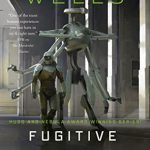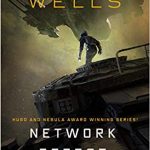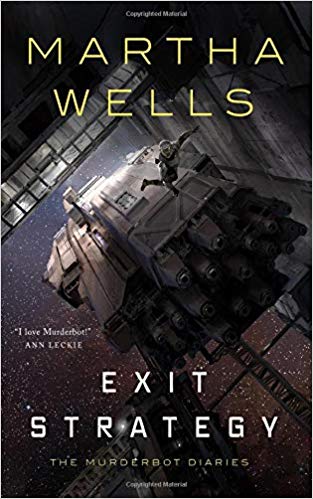 Exit Strategy (The Murderbot Diaries, #4) by Martha Wells
Exit Strategy (The Murderbot Diaries, #4) by Martha Wells Format: eARC
Source: supplied by publisher via Edelweiss
Formats available: hardcover, ebook, audiobook
Genres: science fiction
Series: Murderbot Diaries #4
Pages: 172
Published by Tor.com on October 2, 2018
Purchasing Info: Author's Website, Publisher's Website, Amazon, Barnes & Noble, Kobo, Bookshop.org
Goodreads
Murderbot wasn't programmed to care. So, its decision to help the only human who ever showed it respect must be a system glitch, right?
Having traveled the width of the galaxy to unearth details of its own murderous transgressions, as well as those of the GrayCris Corporation, Murderbot is heading home to help Dr. Mensah — its former owner (protector? friend?) — submit evidence that could prevent GrayCris from destroying more colonists in its never-ending quest for profit.
But who's going to believe a SecUnit gone rogue?
And what will become of it when it's caught?
Our Review:
Marlene: Kind of an ironic title, this. Murderbot really doesn’t have one. An exit strategy, that is. Not for the immediate problem, and not for the overall problem. It is fun and surprisingly heartbreaking watching it try. I say surprising because, after all, Murderbot itself would decry, loudly and often, the concept that it has a heart in anything other than the biological sense – if it actually has one of those. Come to think of it, I’m not completely sure. It does have organic parts, I’m just not sure if it has that part in particular.
Galen: One of the problems with those organic parts is that they sometimes get in the way of certain things that Murderbot would like to do… like fully delete memories it doesn’t wish to carry but nonetheless help to push Murderbot (and the plot) forward. It is fitting that by the end of Exit Strategy, Murderbot finds itself reconstructing its memories… and ending up with, for the first time, a free choice.
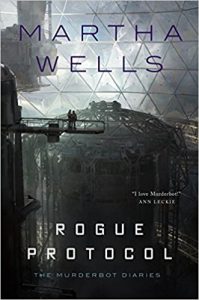 Exit Strategy picks off right where Rogue Protocol left off, with Murderbot knowing exactly what GrayCris was up to. The problem? Dr. Mensah needs to be rescued… and GrayGris is gunning for Murderbot.
Exit Strategy picks off right where Rogue Protocol left off, with Murderbot knowing exactly what GrayCris was up to. The problem? Dr. Mensah needs to be rescued… and GrayGris is gunning for Murderbot.
Marlene: Exit Strategy, along with Murderbot’s lack of an exit strategy, has an “out of the frying pan into the fire” aspect. Or perhaps that should be the “perils of Pauline” with Murderbot substituting for Pauline. It seems to be endlessly in trouble in this one – possibly as part of its own messed-up reactions. It feels a need to help Dr. Mensah, and it doesn’t want to, both at the same time.
Well, really, it does, but it is having endless difficulties admitting why it wants to. There’s certainly a sense that it feels the need to right the wrong that it has inadvertently caused through its actions in Rogue Protocol. It went to investigate GrayCris, at least in part because it wanted to help Dr. Mensah against them. What it didn’t count on was that GrayCris would interpret its self-willed mission as yet another attempt by Dr. Mensah to get to the bottom of whatever crap they seem to be pulling – and that GrayCris would react accordingly. Well, accordingly for an evil corporation at any rate.
Galen: What GrayCris didn’t count on is that Murderbot’s quest changed it. As much as Murderbot likes to talk about retreating to its bad space soap opera media, it spends the entire series of novellas learning and growing. Concretely, this means that by the end of Exit Strategy, Murderbot has taken down opponents that a stock SecUnit has no business even tangling with. While this means that the action in the novella is satisfyingly complicated, Murderbot’s increased capability as a SeUnit is secondary to its growth as an individual. To be clear, not in the Pinocchio-becoming-a-real-boy sense that many stories about artificial constructs and androids follow, as this passage demonstrates:
“I don’t want to be human.”
Dr. Mensah said, “That’s not an attitude a lot of humans are going to understand. We tend to think that because a bot or a construct looks human, its ultimate goal would be to become human.”
“That’s the dumbest thing I’ve ever heard.”
Rather, the sequence of four novellas chronicle’s Murderbot’s growth as a being able to make its own choices, including choosing who to associate with.
Marlene: In the end, that is what is so fascinating about Murderbot – not that its line of snark doesn’t have plenty of charms of its own. Throughout Exit Strategy, Murderbot keeps making choices – and those choices increase in complexity and, for lack of a better word, selfishness. Not that it does things that benefit itself – because the ultimate selfish act would be to freighter-hop while playing its melodramas for the rest of its existence. But its actions have become acts of selfhood and self-determination, even if that determination is to sacrifice itself so that the others can escape.
What it does not reckon on is that those others see it as a person in its own right, just as it sees them. And that its ability to grow, adapt, change, try, fail, succeed and ultimately hope is emblematic of its journey to selfhood. A selfhood that is explicitly not humanity. It is on its way to becoming a real person, but not, as Data once aspired to be, a real boy.
And in its confusion of what all that means, we empathize with it, even as it refuses to become one of us, but still manages to become one of itself.
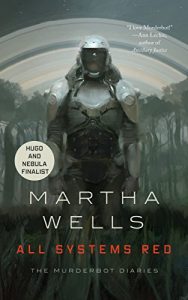 While its growth is far from complete at the end of Exit Strategy, it has reached a point where it has grown enough to begun to acknowledge its own contradictions and confusions, just like the rest of us. And it wraps up the loose ends of this part of the story, the one that began in All Systems Red.
While its growth is far from complete at the end of Exit Strategy, it has reached a point where it has grown enough to begun to acknowledge its own contradictions and confusions, just like the rest of us. And it wraps up the loose ends of this part of the story, the one that began in All Systems Red.
But I’ve just heard a rumor that Murderbot will have a full-length novel coming out in 2020. YAY! Hopefully it will come in time to read on the long plane ride to WorldCon in New Zealand.
Galen: Yay indeed! Which leads me to…
Galen’s Escape Rating A: This is a fitting conclusion to the sequence of four novellas; while it wraps up the central mysteries set up in All Systems Red, there is clearly a lot more we could learn about the setting that Wells has made… and I hope to learn that through Murderbot’s eyes.
Marlene’s Escape Rating A: This is indeed a fitting conclusion to this sequence, while still leaving plenty of open threads that can be picked up in that much anticipated full-length novel. The story as we have it is Murderbot’s journey, in the sense that this is its own story. As the story of a machine being rather than a flesh creature, it is fascinating to see the way that the author has given Murderbot selfhood without falling into any of the traps of either it wanting to be human or of it, heaven forbid, falling in love. Instead, it seems to be reaching for friendship and companionship, and most of all, acceptance. Learning to accept itself as it is will be its biggest challenge – one that it is more than up to.
I hope we get to find out how it manages.








